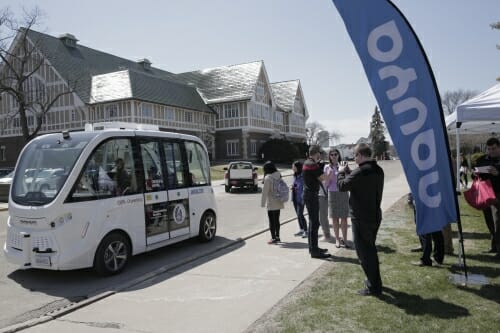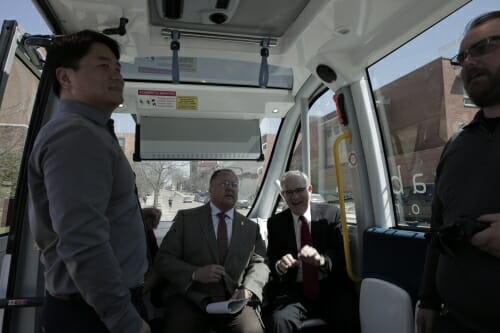Slowly but surely, driverless cars are on their way

The Autonom Shuttle, an 11-seat autonomous vehicle made by the French company Navya, gave passengers a tour of parts of campus. Photo by Renee Meiller
It doesn’t text. It won’t fall asleep. And it never gets road rage.
Driverless cars are the way of the future — and the future visited campus Tuesday and Wednesday. The Autonom Shuttle, an 11-seat autonomous vehicle made by the French company Navya, picked up curious passengers outside of Russell Laboratories and took them for a brief loop covering parts of Linden, Elm, Observatory and Babcock drives.
Who’s driving this thing? Technology, and a team of humans constantly working to improve it.
“A lot of people are skeptical, which is good,” says Peter Rafferty, a program manager at UW–Madison’s Traffic Operations and Safety Laboratory. “We’re not here to sell it, we’re here to ask the right questions.”

Passengers eager to experience the future of transportation file into the Autonom Shuttle for a tour. Photo by Renee Meiller
The UW–Madison College of Engineering is leading the federally designated Wisconsin Automated Vehicle Proving Grounds collaboration (WiscAV). Rafferty and researchers in the TOPS Laboratory are helping drive autonomous and connected vehicle research through projects like a partnership with the City of Madison to test connected vehicle technology on South Park Street. The laboratory also houses a full-scale driving simulator.
Rafferty took his first driverless ride a couple of years ago at a conference.
“I had the luxury of knowing the technology,” Rafferty says. “On one hand, I came away more confident but I also saw that additional work needs to be done.”
More than 90 percent of traffic fatalities are due to human error, according to the U.S. Department of Transportation.
“The motivation for us as engineers is all the safety benefits,” Rafferty says.
The vehicle has eight lidar sensors which helps it detect obstacles and identify things like knowing where the curb is. Lidar works much like radar, but instead of sending out radio waves it emits pulses of infrared light and measures how long they take to come back after hitting nearby objects. It’s not built to handle snow and ice – yet.
It’s a quiet ride, as the vehicle is 100 percent electric. There are 70 Navya shuttles around the world.
Aaron Foster, a sales manager with Navya, came along as an attendant during the drive, answering questions like what would happen if someone ran in front of the vehicle, which was later answered when it not only stopped but gave a gentle but firm honk.
Foster explained that geotags are used to help the vehicle know where stop signs are. People at a bus stop smiled in confusion as they saw the Autonom stop and open its doors.

With no need for a driver, the interior of the Autonom Shuttle has plenty of room. Photo by Renee Meiller
“It’s all part of the education,” Foster says. “We hope the functions continue to progress as time goes on.”
Jennifer Riehl, a postdoctoral fellow in the entomology department, took the five-minute driverless trip on Tuesday. Her husband Jonathan Riel works in the College of Engineering so she was already familiar with the vehicle.
“I’ve been telling everyone about it,” Riehl says. “I can see that this would be a cool thing that would be useful for shorter trips.”
She talked Allyson Richins, a technician in the entomology department, into taking a ride with her.
“It’s very impressive,” Richins says, describing how the vehicle stopped when a woman was crossing the street. “The sensors are strong.”
Justin Knapp and Hunter Celeste, both sophomores studying computer engineering, had been curious about driverless vehicles for a while. Neither are fans of driving on campus.
“It would help to have another form of transportation on campus,” Knapp says. “The bus is not always convenient and there are tons of stops. Having this would be a lot nicer.”
It can reach speeds of 28 miles per hour but it purred somewhere around 15 miles per hour for its campus excursion.
“I felt like I could walk faster,” Knapp says.
Sure, safety is a priority, which makes for a pretty slow and cautious ride, something a car with a driver didn’t appreciate as it gave the ol’ Autonom a honk at a stop sign. The Autonom was unfazed.
“I think it can definitely be something for the future as it gets more prevalent,” Celeste says.
While Rafferty doesn’t see driverless cars taking over any time soon, he does see them gradually becoming part of our transportation landscape. But what about the flying cars we were promised?
“Those are coming too,” Rafferty says.
Right now there are passenger drones flying above Dubai. Rafferty likes to remind people that “The Jetsons” cartoon came out in 1962 and portrayed a futuristic world in 2062.
“That’s only 44 years from now,” Rafferty says. “Things are moving very, very fast.”
Tags: engineering, traffic




